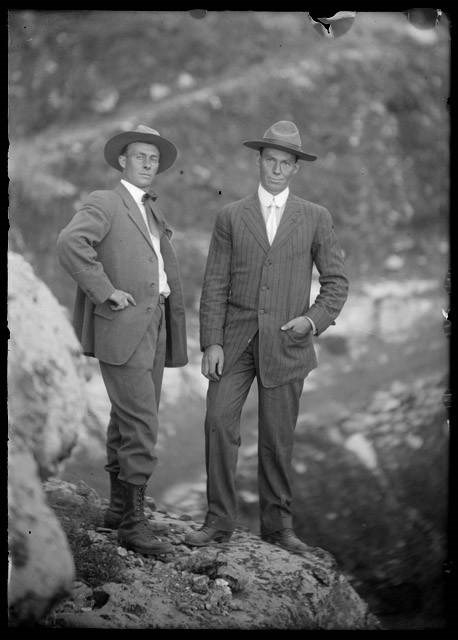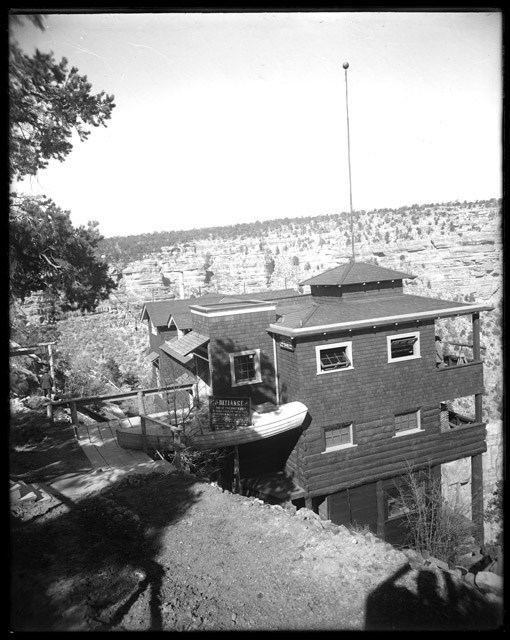Last updated: November 17, 2020
Article
Kolb Brothers: Conflict on the Canyon's Rim

When the train carrying Ellsworth Kolb reached the rim of the Grand Canyon in 1901, there was no El Tovar Hotel or Kolb Studio sitting proudly at the Bright Angel trailhead. Instead, train passengers would stay in small tent cabins and enjoy the natural, auto-free sounds of the canyon. Ellsworth's carefree and adventurous spirit thrived in the freedom and beauty found here.
He persuaded his cautious and aggressive younger brother Emery to come west to work with him. Emery arrived in Williams, AZ in October 1902 with only his camera, guitar, and the clothes on his back. While waiting to catch the train to Grand Canyon, he wandered into a photographic store that happened to be for sale; $425 later, he began their adventure in Northern Arizona.
A year later, the brothers moved their business near a trailhead at Grand Canyon after receiving permission from Ralph Cameron, owner of the Bright Angel Trail. First, they pitched a small tent on the canyon rim, and then built a small wooden house in 1906, which they called Kolb Studio.
Ellsworth and Emery established themselves as both photographers and adventurers during the next 12 years. Their photographs of visitors and lesser-known areas of the canyon supported their chosen career path. However, they were not the only ones who saw an opportunity to earn money this way.
The Arrival of the Fred Harvey Company
They sold their photographs in a leather-bound book for three dollars each. The Fred Harvey Company witnessed the success of the Kolb brothers' photographs, and decided to create a photo album, entering into an exclusive contract with Albertype. The signed contract prohibited working with other Grand Canyon interests, especially the Kolbs. The Kolbs were quickly able to find another photo album company, but this incident set the stage for ongoing conflicts between the Kolbs and the Fred Harvey Company.
The Fred Harvey Company operations at Grand Canyon began with the completion of the El Tovar in 1905; two years after the Kolbs arrived. They were famous for their food, elegant service and "Harvey Girl" waitresses. The company began to acquire businesses to offer better tourist services. They ended up establishing a monopoly. The only two holdouts were the Kolb and Verkamp families.
Journey on the Colorado River
After a few successful years, the brothers decided they needed a new challenge from taking still shots of the canyon. Emery and Ellsworth ran the mighty Colorado River. One hundred and one days of river-running mishaps and triumphs was captured on film using new technology of a motion-picture camera. They wanted to become famous by showing their film in Kolb Studio. The government agency, the National Forest Service, overseeing Grand Canyon at the time, foiled this plan.
The Fred Harvey Company influenced the government into stopping the film from showing in their studio. In retaliation, the brothers toured the eastern United States presenting a successful film lecture series. People packed the theaters to hear about their great adventure.
The one exception was an Ohio tour in 1913 that proved unprofitable. Ellsworth insisted that the brothers take this tour without a guaranteed fee. Emery grudgingly agreed after many days of arguing. When the tour failed, the brothers' already tense relationship grew even more heated, causing them to split the business. A coin-toss granted Emery the studio and Ellsworth moved to Los Angeles, CA. Emery Kolb's family now consisted of wife Blanche and daughter Edith.

The Building of Lookout Studio
Over the years, the Fred Harvey Company watched the success of Kolb Studio and aspired to duplicate it. The company constructed Lookout Studio a short distance away from Kolb Studio in 1914. In conjunction, a mule corral was erected, blocking the rim trail and obscuring the view of Kolb Studio. Emery felt they were trying to deter visitors from coming to his studio. His opinion was confirmed when he learned the El Tovar manager complained that Kolb Studio was taking business away.
Emery's terse comeback was a letter stating that Lookout Studio was "an obstruction to his business". Mr. Ford Harvey, now owner of the company, responded by chastising the El Tovar manager and told him to treat the Kolbs better because "Emery's lecturing was helping to promote Canyon business".
In the introduction, author Owen Wister recorded his experiences at Grand Canyon when Harvey employees attempted to hinder him and his wife from visiting Kolb Studio: “… crush their little studio, stifle their little trade, push their genuine artists and lovers of nature away from the Canyon …”
Harvey solicited Wister to retract the statement; Wister refused. Harvey decided to negotiate directly with Emery. They agreed that Harvey employees would provide accurate information regarding Kolb Studio and the Wister statement would be removed from the next edition. The feud between the Kolbs and the Fred Harvey Company momentarily subsided.
Creation of Grand Canyon National Park
Change came with the creation of Grand Canyon National Park in 1919 when the Kolb family signed the first of many ten-year concession agreements. During the twenties, tourism grew exponentially allowing all businesses to prosper.
The Great Depression caused a significant business downfall. However, Emery blamed the decline of his business on new park regulations. One regulation passed in 1932 stated that any public advertising or soliciting was strictly prohibited. When Emery received the memo from the superintendent, he immediately scribbled back declaring his dissatisfaction with this regulation and that this would be detrimental to the Kolbs' business. The foundation of their 44 year contentious relationship was set.

Emery continued protesting against the advertising policy for five years. In August, he met with Victor Patrosso, manager of two Fred Harvey hotels, who agreed to display literature provided by the Kolbs. Patrosso acquiesced by placing a directional sign to Kolb Studio by the El Tovar and Bright Angel Hotels. Emery dismissed this idea because he knew these advertisements would miss the majority of visitors in automobiles. In September, another proposal was made that Emery be allowed to distribute advertising literature to arriving visitors at different points within the park.
The park staff decided that Patrosso's plan was more in line with the agencies' policies and implemented. Conflict between the two groups abated until Emery was presented a three-year concession agreement in 1962 with a clause that stated Kolb Studio would be taken by the park service upon his death. The park service desired to demolish the studio because its architecture wasn't in keeping with the style of the other buildings. Emery refused to sign the contract expressing it would deprive his daughter Edith of the family business.
He appealed to Carl Hayden, US Senator from AZ for help. Hayden convinced the park service to extend the contract from three years to five years, but was unable to persuade the agency to remove the clause. Emery demanded $65,000 for the studio and all rights to live there until his death. The conflict continued until Congress passed the Historic Sites Act that states any park structure over 50 years old cannot be destroyed.
Conflict between the two groups abated until Emery was presented a three-year concession agreement in 1962 with a clause that stated Kolb Studio would be taken by the park service upon his death. The park service desired to demolish the studio because its architecture wasn't in keeping with the style of the other buildings. Emery refused to sign the contract expressing it would deprive his daughter Edith of the family business. He appealed to Carl Hayden, US Senator from AZ for help. Hayden convinced the park service to extend the contract from three years to five years, but was unable to persuade the agency to remove the clause. Emery demanded $65,000 for the studio and all rights to live there until his death. The conflict continued until Congress passed the Historic Sites Act that states any park structure over 50 years old cannot be destroyed.
With the knowledge that Kolb Studio would endure, Emery began to give away his belongings and pondered what would happen to his photographs upon his death. The park's museum curator had hoped he would donate his papers and photographs to them. However, Emery gave his life's work to the University of Northern Arizona in Flagstaff, AZ. He died in December 1976 at 96, and is buried in Grand Canyon Pioneer Cemetery.

Kolb Studio Today
Kolb Studio proudly sits at the head of the Bright Angel Trial, just like it did in 1904. It is a monument to Emery Kolb's achievement and success over the Fred Harvey Company's never-ending effort to make him leave and the National Park Service's yearning to obliterate it.
A visit to Kolb Studio allows you the opportunity to walk in Emery Kolb's footsteps and hear stories of his life. His adventures endured significant changes since he first stepped off the train in1902. His canyon rim home, entrusted to the National Park Service, is a lasting legacy of perseverance to fulfill one's dreams.
